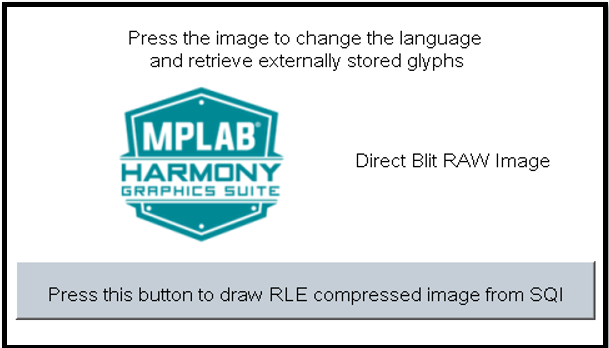
The Quickstart External Resource examples are made available in 3 methods below. Each mode demonstrates reading multiple images, multi-lingual strings and multiple font assets from both internal and external non-volatile memory (NVM).
These demonstrations are provided for application designs requiring multiple images or non-alphabet-based languages with large number of glyphs, have a very large NVM requirement for their graphics resources. In such applications, storing these graphics resources on-chip may be inefficient or impossible. The solution is to store the graphics resources to off-chip NVM, thereby preserving the on-chip NVM for program memory and allowing for more complex functional features.
Note: The application is purposely setup in single-buffer configuration to allow visual inspection of the data retrieval speed of the various images and glyphs. Observation of visual artifacts are expected.
For more information, see the following methods specified by their naming conventions.
|
Resource Mode |
Naming Convention |
|
x_r (external resource) |
|
Name |
Description |
|
The legato_quickstart_external_resources (external flash reader) application demonstrates reading multiple images, multi-lingual strings and multiple font assets from both internal and external non-volatile memory (NVM). The external resources are pre-programmed into the NVM using the legato_flash demonstration application. The intent of legato_quickstart_external_resources (external flash reader) application is to demonstrate Legato Graphics Library’s ability to support assets stored on external NVM. Another intent is to highlight possible draw performance drawbacks with these techniques and to serve as a guiding post for UI application designers on their judicious use. Refer to legato_flash for external NVM programming information. | |
|
This application runs on the  SAM E54 Curiosity Ultra Development Board using an external ILI9488 display controller to drive the SAM E54 Curiosity Ultra Development Board using an external ILI9488 display controller to drive the  maXTouch® Curiosity Pro Board. maXTouch® Curiosity Pro Board. |
|
MPLAB® Harmony Graphics Suite
|